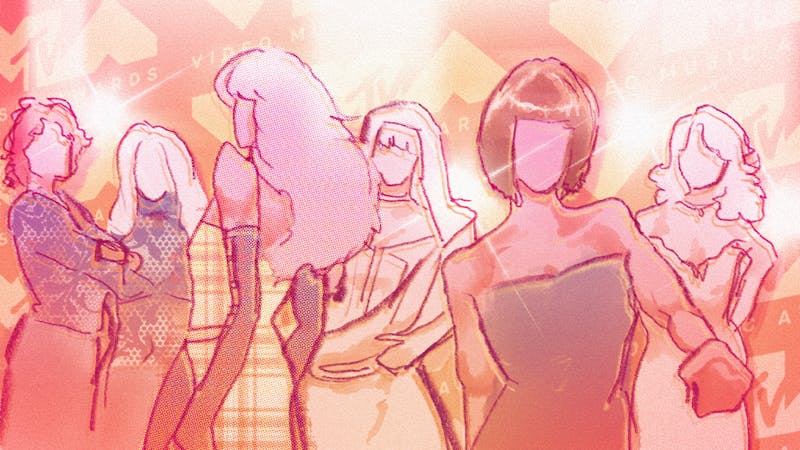Fashion
The Fashion Frontier of the 2024 VMAs

What do Megan Thee Stallion and Britney Spears have in common? If you answered with a live ball python scarf, you’d be correct. When the biggest names in music gathered at UBS Arena in Elmont, New York for the 40th MTV Video Music Awards, it wasn’t just about who would take home a Moonman. Although Taylor Swift, Post Malone, and Sabrina Carpenter might have clinched the triple crown (the Video, Artist, and Song of the Year awards), it was the red carpet that captured the interest of viewers nationwide. There, the only rule is that there are none. Whether it’s messy references, gaudy glamor, or performance art, the VMA runway truly embraces an “anything goes” approach to an award show.
From its origin in the Madonna–curated MTV era of the 1980s, the VMAs are the black sheep of high–brow award shows. While celebrities at the Oscars and Grammys often adorn the newest innovations in designer haute couture, the VMA red carpet thrives on shock value and spectacle. Just think of Madonna’s deconstructed wedding dress paired with a “Boy Toy” belt, Lady Gaga’s meat dress, or Lil Kim’s one–shouldered jumpsuit paired with a tasteful seashell pasty. You could say elevating the moment and pushing the envelope are the VMAs’ bread and butter. And this year, pushing the envelope on the red carpet meant looking back.
This year, the award show was imbued with a strange sense of Y2K deja vu. Host Megan Thee Stallion paid homage to Britney Spears’ Slave 4 U performance at the 2001 VMAs, complete with a live ball python and body glitter. Tate McRae also channeled Spears by recreating her 2001 VMAs red carpet look in a black lace mini dress. Additionally, Addison Rae’s tutu, feathers, and undies moment evoked Bjork’s iconic swan dress from the 2001 Academy Awards and her album Vespertine (2001). Not to mention, Chappell Roan embodied a modern Joan of Arc in chainmail gloves, an ornamented green velvet cape, and chunky cross pendant. One could even argue the tartan in Taylor Swift’s Dior Resort Wear ensemble was inspired by Cher Horowitz’s iconic yellow–checked matching set from Clueless (1995).
In an age where fleetingly fast fashion and microtrends dominate social media, the 2024 VMAs red carpet reminds us why some outfits remain ingrained in our collective cultural memory. Britney’s python–draped body, Bjork’s swan dress, Cher Horowitz’s yellow plaid—they’re no longer mere moments, they’ve become cultural artifacts. As my third–favorite playwright, Eugene O’Neill, once wrote, “There is no present or future—only the past, happening over and over again—now.” Coco Chanel modified his sentiment, believing “fashion changes, but style endures.” If the words of these style gurus prove true, these outfits are destined to live on in popular culture for years to come, constantly repeating themselves in a referential cycle.
So why, in 2024, are we revisiting the early 2000s and late 1990s, an era often made fun of for its emphasis on all things denim, Juicy Couture tracksuits, and bedazzling everything? James Laver, curator of the Victoria and Albert Museum from the 1930s through the 1950s, has an answer for that. In an attempt to define the trend cycle, Laver theorized that all fashion trends must inevitably resurface. Laver’s Law originally posited that a style would go through various stages: an outfit was “indecent” ten years before its time, “smart” as a current fashion, and “dowdy” a year after its time. The style cycles back to “amusing” thirty years after its time, “charming” seventy years after its time, and “romantic” one hundred years after its time. Laver’s process originally documented a 150–year cycle, but excessive consumerism reduced that to the “20–year rule” many fashion enthusiasts follow today. Rising fast fashion giants SHEIN and Temu capitalize on commodity culture by uploading thousands of new items to their virtual storefronts every day. The digital marketplace’s endless options leaves consumers befuddled with the paradox of choice where the options are to consume or be consumed.
Yet, even in a world of microtrends, where the popularity of a piece lasts as long as a TikTok video, the “20–year rule” endures and explains the resurgence of the Y2K and McBling aesthetics at the 2024 VMAs. But the Y2K revival isn’t just on the red carpet—Burberry’s Spring/Summer 2025 runway at London Fashion Week featured models adorned in layered polo shirts, bubble–hem skirts, and shrunken leather jackets.This early aughts influence diffused down to the masses as well—Penn students pair their Ralph Lauren sweaters and Goyard totes with low–waisted jeans and Tiffany heart tag necklaces, embracing these Y2K styles as if they never went out of vogue.
The referential looks that define the 2024 VMA red carpet may never exist in the everyday world outside of Halloween costumes, but VMA viewers still leave the three–hour award show with new inspiration. Year after year, “anything goes” fashion forays trickle down to the fans, pushing their personal style boundaries. The ball python might not be flaunted down Locust anytime soon, but if my vintage low–rise Levi’s are anything to go off of, expect to see an influx of the early aughts coming to a wardrobe near you.








